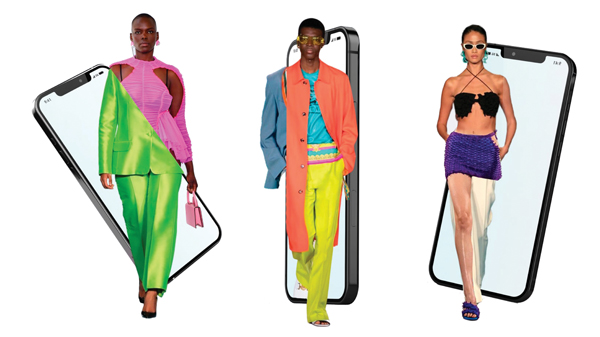
Smart Fashion: Marrying luxury fashion with the latest in technology
Technology has always been the essence of fashion. At a commercial level, consumers do not pay that much attention to the meaning the clothes convey upon purchasing – unmindful that fashion and technology comes hand in hand. The fast-paced progress of technology complements fashion’s ever-evolving aesthetic and landscape. As a result, artificial intelligence is pushing its way to the forefront of the fashion industry, bringing forth a new era of garment manufacturing and sustainable production. This not only offers fresh looks and ground-breaking fabrics, but the opportunity to step forward in practicing clean, sustainable and eco-friendly living.

Shifting Silhouettes
Traditionally, clothes are created with the basic knowledge of hydraulics for function purposes and design, making it as much a field for technological innovation as an arena of style. Technological advances continue to underpin fashion, taking garment design and manufacturing technologies dramatically forward, to the extent that clothing can now be computerised, and computers can in turn create garments to be worn.
As new automated processes and techniques start to replace human skills, future notions of what fashion can achieve will be radically different from the current ones. Innovations such as laser-cut fabric technology, body scanning and nanotechnology with temperature-sensitive textiles, no-wash fabrics and phase-change materials (which stores and releases heat), are state-of-the-art technology that improve functionality as well as fit.

As often seen in lifestyle brands such as Nike and Lululemon, a new style of technologised clothing, also commonly known as ‘techwear’ or ‘wearables’. These are garments that are developed based on technological principles that also follow current fashion trends. With computers practically sewn into modern day garbs, clothing may be just another means of storing data in the future. Although today’s garments are conceived as individual structures, the technological interfaces that characterise these acoutrements will make fabrics a part of the global system in the future – proving fashion is more than just a façade.

The future of fashion will deliver more than a technological portal, making garments inextricably intertwined with one’s experience of wearing them. In fact, many fields of design are already exploring sustainable textile, fabcrics inspired by biomimicry is one example, allowing garments to thicken in autumn and slim down in spring – making linings and layers unnecessary. Some innovations are created with the aim of prolonging the garments’ lifespan. Forever clean fabrics and ‘sweat-proof’ shirts will transform clothing from wash-and-wear into self-cleaning or non-wash materials. As a result, seams will stop twisting out of shape and detailing will no longer fray or disintegrate, allowing clothes to look fresher for longer and giving them an extended life. Hence, well-tailored garments will continue to prevail, while throwaway chic may soon be obsolete.
Clothes Beyond Clout
The word sustainability has been dominating the fashion industry long before the term ‘woke’ made its way into our everyday vocabulary.Whether it is re-purposing used and old materials or simply opting for a much more eco-friendly alternatives, there are many ways to make an impact that are better for the earth, while still enjoyin the aesthetic fashion allows. However, it is easier said than done as sustainability has become somewhat of a marketing ploy for some major brands.

So, what exactly does sustainable fashion ential? It means eco-friendly practices on multiple levels across the industry, referencing the approach of design, production and consumption of clothes and accessories that avoid causing little to no damage to the earth, and in turn creating an industry practice that is sustainable for the environment. In an industry not always known for its transparency, consumers may look to brands that put an emphasis on transparency in their supply chain.

A leading example is Stella McCartney. She has earned public appreciation for her epynomous label’s business model and brand DNA that put sustainability, fair trade and anti-animal cruelty at the forefront of its production and supply chain long before sustainability was a hot topic.
Never mixing sustainability with non-sustainable components, while also excludeing products made from leather, fur and PVC. In 2005, the brand collaborated with sneaker giant Adidas to create ‘Adidas by Stella McCartney,’ a collection of sustainable sneakers and activewear that pushed the boundaries of what it meant to create an open and green ethos. In 2014, the brand launched Clevercare, a five-step labelling system that provides guided information on maintaining clothes – reducing waste and making each item a timeless piece.

More than just a high-fashion designer, Vivienne Westwood is also an activist that champions eco-friendly luxury fashion. In her Fall 2022 collection, the creative team opted for eorganic cotton, recycled polyester and nylon, as well as natural fabrics, led by the motto ‘Buy less, choose well, make it last’ at its core. According to the company website, they emphasise on making clothes with greater care, promoting arts and culture, while trying to mobilise people around climate change and human rights. These star examples pave the way for luxury fashion to take an ethical approach and move the needle in the right direction. With room for growth, the path forward cannot be an all-or-nothing approach.

Fashion Forward and Onward
On the other side of fashion’s future horizon, ‘life-cycle’ clothing is inspiring a new paradigm for fashion retail. Thrusting upcycled garments to the top of consumer goods, this practice takes old garments apart, remake them into entirely new fashion pieces that surpass their second-hand status and give them the same prestige as brand new clothings.
Fashion retail as we know it is already exploring a future in which consumers can contribute to the production cycle. No longer limited to the shelves of boutiques, consumers are taking a more active role in the creation process. As fashion companies depart from conventional retail, they are establishing fresh forums that enable brands to communicate with their consumers effectively, transforming their relationship with clothes – physically and emotionally. This reflects our ever evolving connection to fashion and technology.
(Text: Joseff Musa)







